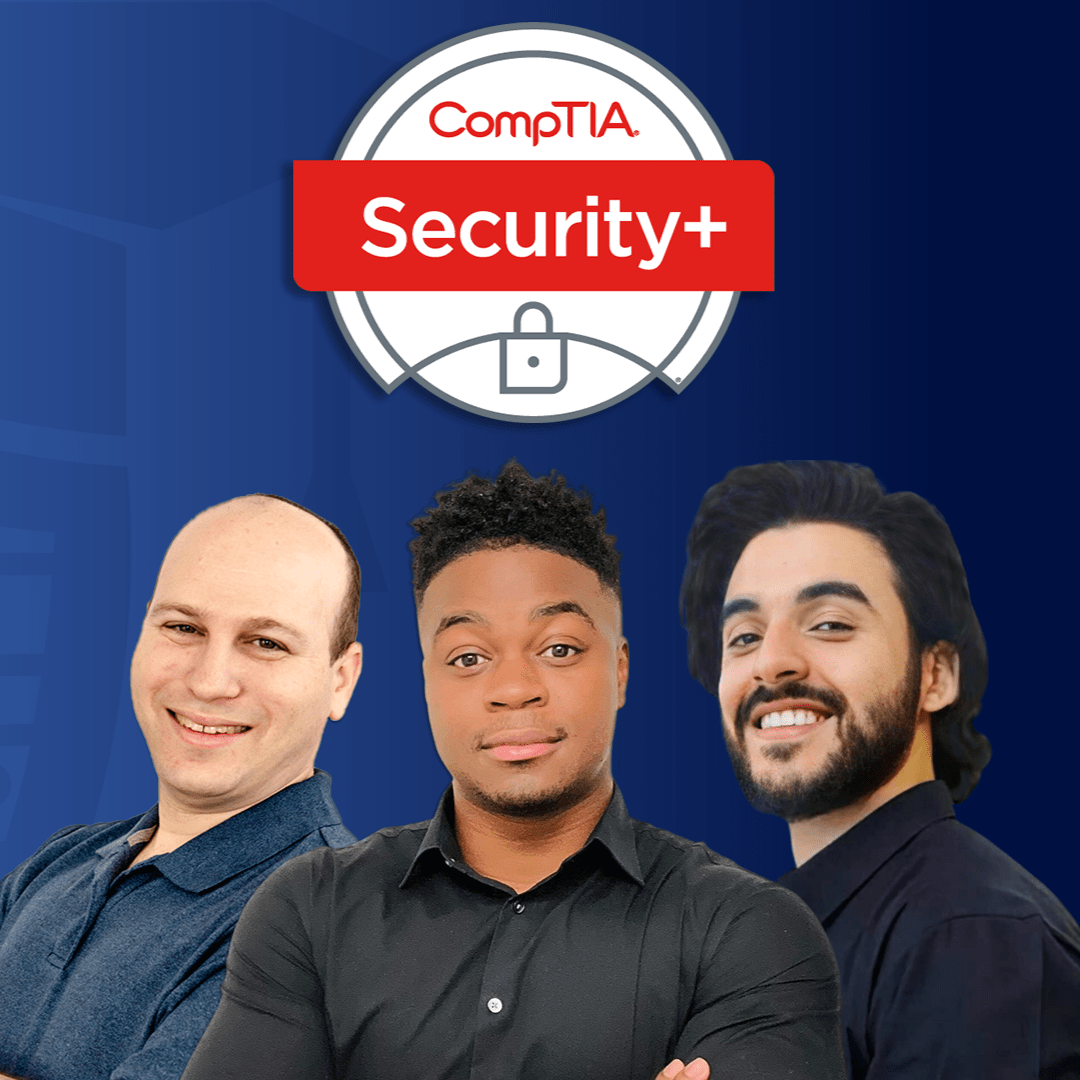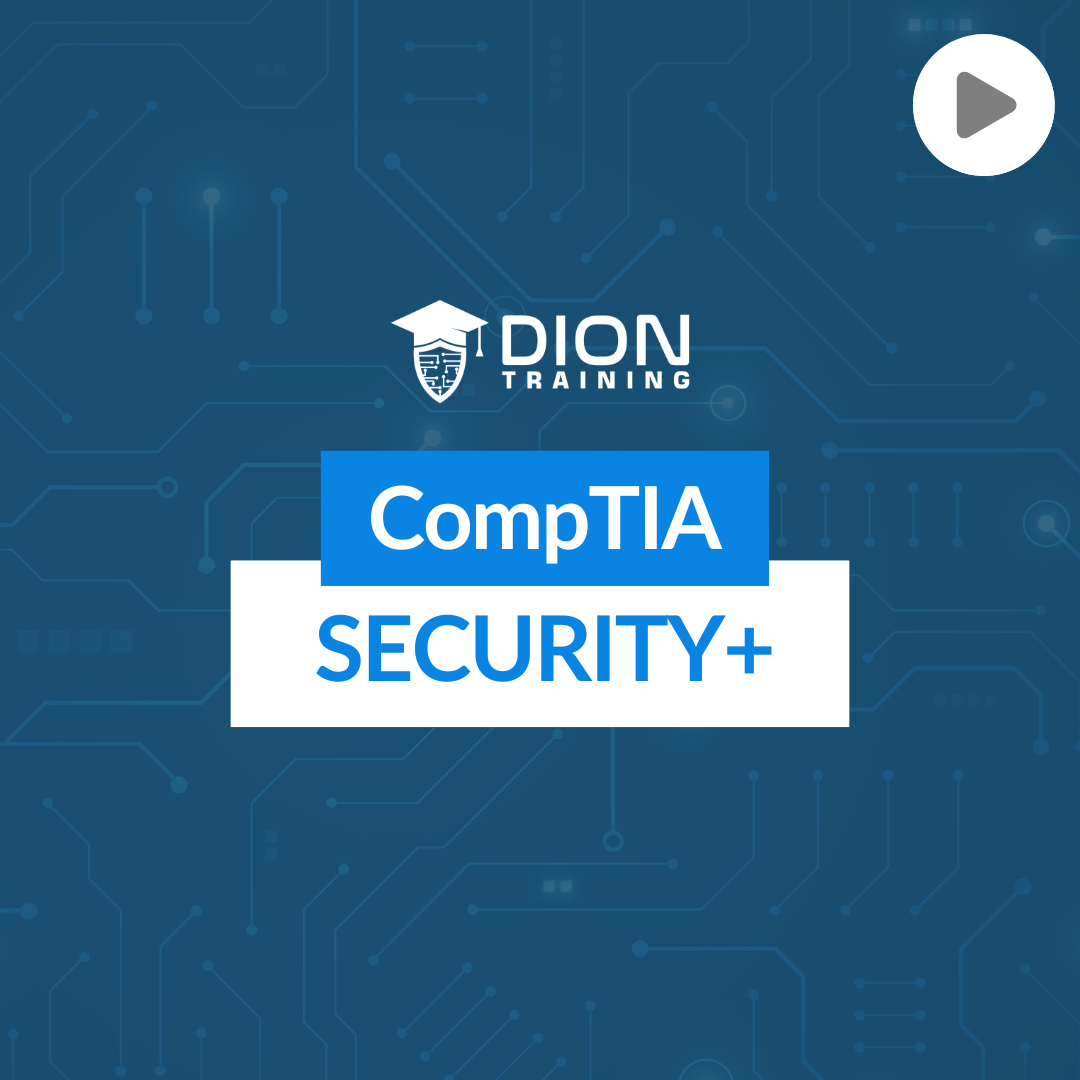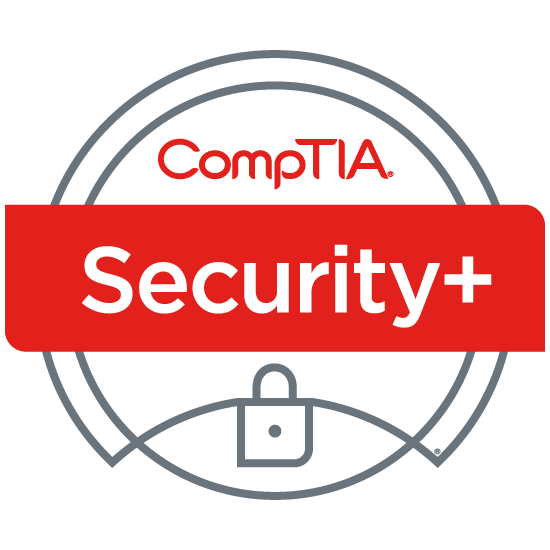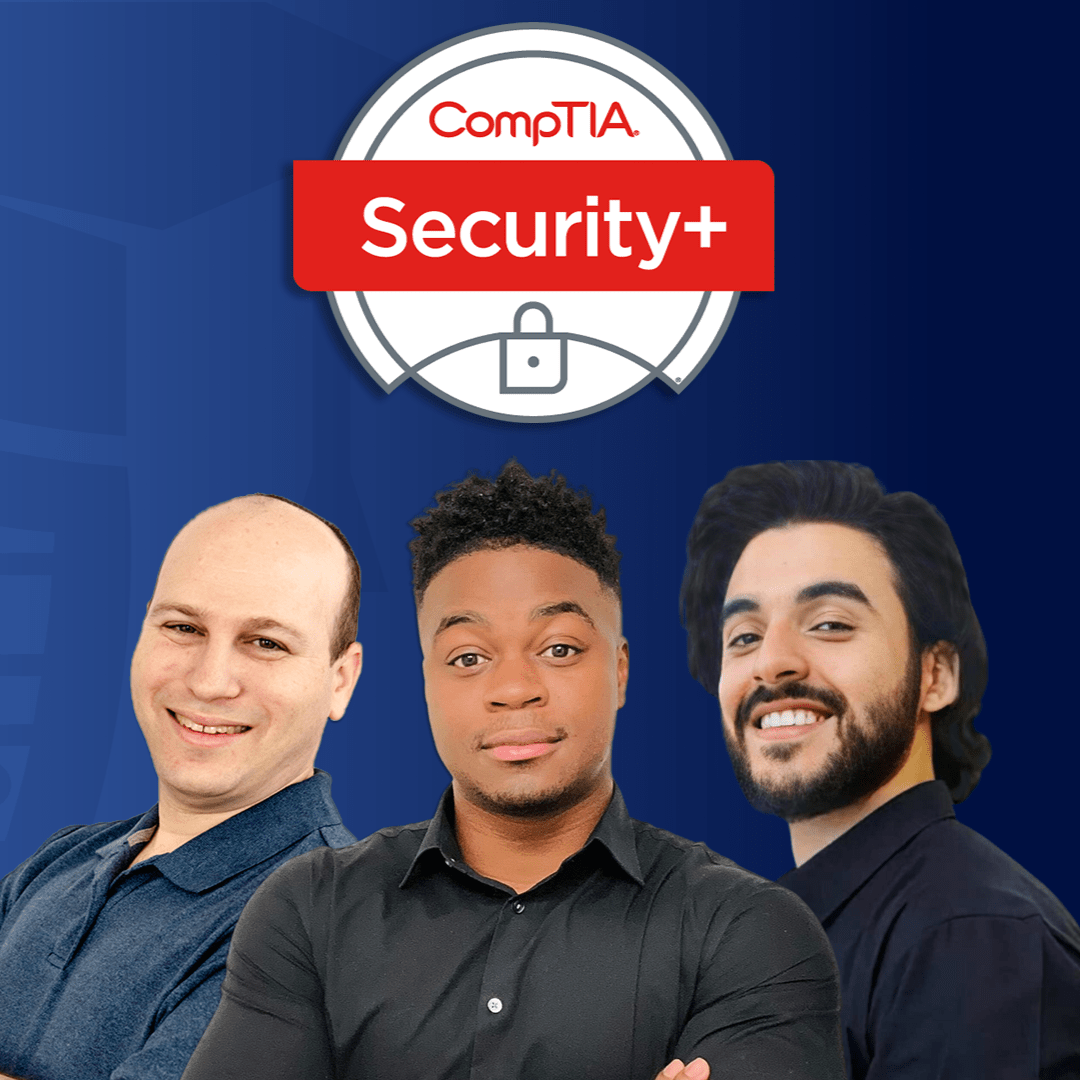
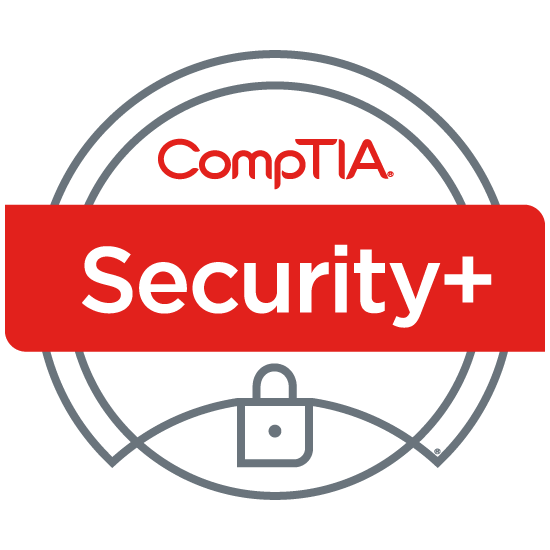
Modules
1 -
Introduction

#
Lesson
Duration
Type
1.
Introduction
FREE
14m:52s
 FREE
FREE
2.
Download your free study guide
 PDF
PDF
3.
Exam Tips
FREE
7m:18s
 FREE
FREE
4.
60 Day Pass Guarantee
FREE
3m:43s
 FREE
FREE
5.
Lab: Exploring the Lab Environment
 Lab
Lab
6.
Checkpoint: Introduction
 Quiz
Quiz
2 -
Fundamentals of Security

#
Lesson
Duration
Type
1.
Fundamentals of Security
FREE
9m:6s
 FREE
FREE
2.
Threats and Vulnerablities
FREE
5m:30s
 FREE
FREE
3.
Confidentiality
5m:51s
 Video
Video
4.
Integrity
6m:6s
 Video
Video
5.
Availability
6m:25s
 Video
Video
6.
Non-repudiation
5m:7s
 Video
Video
7.
Authentication
6m:43s
 Video
Video
8.
Authorization
3m:25s
 Video
Video
9.
Accounting
3m:58s
 Video
Video
10.
Security Control Categories
4m:46s
 Video
Video
11.
Security Control Types
5m:19s
 Video
Video
12.
Lab Configuring Examples of Security Control Types
 Lab
Lab
13.
Gap Analysis
5m:7s
 Video
Video
14.
Lab: Perform System Configruation Gap Analysis
 Lab
Lab
15.
Zero Trust
7m:37s
 Video
Video
16.
Checkpoint: Fundamentals of Security
 Quiz
Quiz
3 -
Threat Actors

#
Lesson
Duration
Type
1.
Threat Actors
4m:9s
 Video
Video
2.
Threat Actor Motivations
7m:46s
 Video
Video
3.
Threat Actor Attributes
4m:34s
 Video
Video
4.
Unskilled Attackers
3m:12s
 Video
Video
5.
Hacktivists
4m:6s
 Video
Video
6.
Organized Crime
4m:36s
 Video
Video
7.
Nation-state Actor
7m:5s
 Video
Video
8.
Insider Threats
6m:8s
 Video
Video
9.
Shadow IT
5m:25s
 Video
Video
10.
Threat Vectors and Attack Surfaces
9m:0s
 Video
Video
11.
Outsmarting Threat Actors
10m:50s
 Video
Video
12.
Checkpoint: Threat Actors
 Quiz
Quiz
4 -
Physical Security

#
Lesson
Duration
Type
1.
Physical Security
3m:41s
 Video
Video
2.
Fencing and Bollards
6m:28s
 Video
Video
3.
Attacking with Brute Force
5m:43s
 Video
Video
4.
Surveillance Systems
7m:2s
 Video
Video
5.
Bypassing Surveillance Systems
4m:26s
 Video
Video
6.
Access Control Vestibules
7m:35s
 Video
Video
7.
Door Locks
13m:14s
 Video
Video
8.
Access Badge Cloning
8m:41s
 Video
Video
9.
Checkpoint: Physical Security
 Quiz
Quiz
5 -
Social Engineering

#
Lesson
Duration
Type
1.
Social Engineering
4m:11s
 Video
Video
2.
Motivational Triggers
10m:46s
 Video
Video
3.
Impersonation
8m:17s
 Video
Video
4.
Pretexting
4m:17s
 Video
Video
5.
Phishing Attacks
8m:46s
 Video
Video
6.
Preventing Phishing Attacks
9m:5s
 Video
Video
7.
Conducting an Anti-Phishing Campaign
5m:21s
 Video
Video
8.
Frauds and Scams
6m:29s
 Video
Video
9.
Influence Campaigns
5m:47s
 Video
Video
10.
Other Social Engineering Attacks
9m:31s
 Video
Video
11.
Lab: Using SET to Perform Social Engineering
 Lab
Lab
12.
Checkpoint: Social Engineering
 Quiz
Quiz
6 -
Malware

#
Lesson
Duration
Type
1.
Malware
8m:49s
 Video
Video
2.
Viruses
7m:49s
 Video
Video
3.
Worms
3m:22s
 Video
Video
4.
Trojans
3m:56s
 Video
Video
5.
Viruses and Trojans
7m:43s
 Video
Video
6.
Ransomware
8m:7s
 Video
Video
7.
Zombies and Botnets
5m:1s
 Video
Video
8.
Rootkits
5m:21s
 Video
Video
9.
Backdoors and Logic Bombs
5m:40s
 Video
Video
10.
Keylogger
5m:4s
 Video
Video
11.
Spyware and Bloatware
5m:2s
 Video
Video
12.
Malware Attack Techniques
4m:58s
 Video
Video
13.
Indications of Malware Attacks
5m:16s
 Video
Video
14.
Lab: Detecting and Responding to Malware
 Lab
Lab
15.
Checkpoint: Malware
 Quiz
Quiz
7 -
Data Protection

#
Lesson
Duration
Type
1.
Data Protection
3m:16s
 Video
Video
2.
Data Classifications
8m:19s
 Video
Video
3.
Data Ownership
5m:10s
 Video
Video
4.
Data States
5m:19s
 Video
Video
5.
Data Types
4m:33s
 Video
Video
6.
Data Soverignty
2m:56s
 Video
Video
7.
Securing Data
4m:0s
 Video
Video
8.
Data Loss Prevention (DLP)
4m:0s
 Video
Video
9.
Configuring a DLP
16m:3s
 Video
Video
10.
Checkpoint: Data Protection
 Quiz
Quiz
8 -
Cryptographic Solutions

#
Lesson
Duration
Type
1.
Cryptographic Solutions
11m:58s
 Video
Video
2.
Symmetric vs Asymmetric
7m:54s
 Video
Video
3.
Symmetric Algorithms
5m:58s
 Video
Video
4.
Asymmetric Algorithms
7m:20s
 Video
Video
5.
Hashing
10m:34s
 Video
Video
6.
Increasing Hash Security
7m:42s
 Video
Video
7.
Lab: Using Hashing and Salting
 Lab
Lab
8.
Public Key Infrastructure (PKI)
6m:2s
 Video
Video
9.
Digital Certificates
13m:3s
 Video
Video
10.
Exploring Digital Certificates
3m:31s
 Video
Video
11.
Blockchain
5m:36s
 Video
Video
12.
Encryption Tools
5m:52s
 Video
Video
13.
Obfuscation
8m:55s
 Video
Video
14.
Cryptographic Attacks
15m:10s
 Video
Video
15.
Checkpoint: Cryptographic Solutions
 Quiz
Quiz
9 -
Risk Management

#
Lesson
Duration
Type
1.
Risk Management
4m:43s
 Video
Video
2.
Risk Assessment Frequency
3m:25s
 Video
Video
3.
Risk Identification
6m:0s
 Video
Video
4.
Risk Register
7m:56s
 Video
Video
5.
Qualitative Risk Analysis
3m:46s
 Video
Video
6.
Quantiative Risk Analysis
5m:11s
 Video
Video
7.
Risk Management Strategies
5m:32s
 Video
Video
8.
Risk Monitoring and Reporting
3m:39s
 Video
Video
9.
Checkpoint: Risk Management
 Quiz
Quiz
10 -
Third-party Vendor Risks

#
Lesson
Duration
Type
1.
Third-party Vendor Risks
3m:2s
 Video
Video
2.
Supply Chain Risks
4m:10s
 Video
Video
3.
Supply Chain Attacks
6m:19s
 Video
Video
4.
Vendor Assessment
5m:3s
 Video
Video
5.
Vendor Selection and Monitoring
5m:11s
 Video
Video
6.
Contracts and Agreements
5m:15s
 Video
Video
7.
Checkpoint: Third-party Vendor Risks
 Quiz
Quiz
11 -
Governance and Compliance

#
Lesson
Duration
Type
1.
Governance and Compliance
4m:51s
 Video
Video
2.
Governance
5m:4s
 Video
Video
3.
Governance Structures
3m:34s
 Video
Video
4.
Policies
5m:21s
 Video
Video
5.
Standards
4m:30s
 Video
Video
6.
Procedures
4m:52s
 Video
Video
7.
Governance Considerations
7m:9s
 Video
Video
8.
Compliance
5m:48s
 Video
Video
9.
Non-compliance Consequences
4m:1s
 Video
Video
10.
Checkpoint: Governance and Compliance
 Quiz
Quiz
12 -
Asset and Change Management

#
Lesson
Duration
Type
1.
Asset and Change Management
4m:42s
 Video
Video
2.
Acqusition and Procurement
6m:19s
 Video
Video
3.
Mobile Asset Deployments
6m:16s
 Video
Video
4.
Asset Management
6m:34s
 Video
Video
5.
Asset Disposal and Decommissioning
8m:57s
 Video
Video
6.
Lab: Performing Drive Sanitization
 Lab
Lab
7.
Change Management
7m:6s
 Video
Video
8.
Change Management Processes
6m:20s
 Video
Video
9.
Technical Implictions of Changes
4m:46s
 Video
Video
10.
Documenting Changes
4m:27s
 Video
Video
11.
Checkpoint: Asset and Change Management
 Quiz
Quiz
13 -
Audits and Assessments

#
Lesson
Duration
Type
1.
Audits and Assessments
4m:51s
 Video
Video
2.
Internal Audits and Assessments
7m:43s
 Video
Video
3.
Performing an Internal Assessment
4m:26s
 Video
Video
4.
External Audits and Assessments
7m:10s
 Video
Video
5.
Performing an External Asessment
4m:39s
 Video
Video
6.
Penetration Testing
6m:34s
 Video
Video
7.
Reconnaissance in Pentesting
19m:43s
 Video
Video
8.
Lab: Performing Reconnaissance
 Lab
Lab
9.
Performing a Basic PenTest
19m:41s
 Video
Video
10.
Lab: Performing Penetration Testing
 Lab
Lab
11.
Attestation of Findings
6m:30s
 Video
Video
12.
Checkpoint: Audits and Assessments
 Quiz
Quiz
14 -
Cyber Resilience and Redundancy

#
Lesson
Duration
Type
1.
Cyber Resilience and Redundancy
3m:13s
 Video
Video
2.
High Availability
9m:2s
 Video
Video
3.
Data Redundnacy
8m:48s
 Video
Video
4.
Configuring a RAID
3m:38s
 Video
Video
5.
Capacity Planning
8m:2s
 Video
Video
6.
Powering Data Centers
10m:41s
 Video
Video
7.
Data Backups
10m:39s
 Video
Video
8.
Lab: Implement Backups
 Lab
Lab
9.
Continuity of Operations Plan
9m:13s
 Video
Video
10.
Redundant Site Considerations
12m:15s
 Video
Video
11.
Resilience and Recovery Testing
6m:55s
 Video
Video
12.
Checkpoint: Cyber Resilience and Redundancy
 Quiz
Quiz
15 -
Security Architecture

#
Lesson
Duration
Type
1.
Security Architecture
4m:13s
 Video
Video
2.
On-premise versus the Cloud
11m:28s
 Video
Video
3.
Cloud Security
6m:27s
 Video
Video
4.
Virtualization and Containerization
10m:38s
 Video
Video
5.
Lab: Using Virtualization
 Lab
Lab
6.
Lab: Using Containers
 Lab
Lab
7.
Serverless
3m:41s
 Video
Video
8.
Microservices
4m:13s
 Video
Video
9.
Network Infrastructure
3m:18s
 Video
Video
10.
Software-Defined Network (SDN)
3m:11s
 Video
Video
11.
Infrastructure as Code (IaC)
4m:26s
 Video
Video
12.
Centralized vs Decentralized Architectures
4m:18s
 Video
Video
13.
Internet of Things (IoT)
5m:6s
 Video
Video
14.
ICS and SCADA
4m:7s
 Video
Video
15.
Embedded Systems
5m:9s
 Video
Video
16.
Checkpoint: Security Architecture
 Quiz
Quiz
16 -
Security Infrastructure

#
Lesson
Duration
Type
1.
Security Infrastructure
4m:37s
 Video
Video
2.
Ports and Protocols
15m:20s
 Video
Video
3.
Firewalls
12m:11s
 Video
Video
4.
Configuring Firewalls
13m:57s
 Video
Video
5.
Lab: Implementing a Firewall
 Lab
Lab
6.
IDS and IPS
6m:26s
 Video
Video
7.
Network Appliances
9m:57s
 Video
Video
8.
Port Security
10m:48s
 Video
Video
9.
Securing Network Communications
20m:31s
 Video
Video
10.
Lab: Setting Up Remote Access
 Lab
Lab
11.
Lab: Using IPSec Tunneling
 Lab
Lab
12.
SD-WAN and SASE
7m:40s
 Video
Video
13.
Infrastructure Considerations
10m:54s
 Video
Video
14.
Selecting Infrastructure Controls
8m:15s
 Video
Video
15.
Checkpoint: Security Infrastructure
 Quiz
Quiz
17 -
Identity and Access Management (IAM) Solutions

#
Lesson
Duration
Type
1.
Identity and Access Management (IAM) Solutions
4m:30s
 Video
Video
2.
Identity and Access Management (IAM)
4m:57s
 Video
Video
3.
Multifactor Authentication
15m:17s
 Video
Video
4.
Password Security
16m:51s
 Video
Video
5.
Lab: Managing Password Security
 Lab
Lab
6.
Password Attacks
10m:9s
 Video
Video
7.
Single Sign-On (SSO)
9m:51s
 Video
Video
8.
Federation
5m:6s
 Video
Video
9.
Privileged Access Management (PAM)
3m:20s
 Video
Video
10.
Access Control Models
9m:7s
 Video
Video
11.
Assigning Permissions
7m:1s
 Video
Video
12.
Lab: Managing Permissions
 Lab
Lab
13.
Checkpoint: Identity and Access Management (IAM) Solutions
 Quiz
Quiz
18 -
Vulnerabilities and Attacks

#
Lesson
Duration
Type
1.
Vulnerabilities and Attacks
6m:35s
 Video
Video
2.
Hardware Vulnerabilities
6m:34s
 Video
Video
3.
Bluetooth Vulnerabilities and Attacks
6m:41s
 Video
Video
4.
Mobile Vulnerabilities and Attacks
5m:1s
 Video
Video
5.
Zero-day Vulnerabilities
5m:3s
 Video
Video
6.
Operating System Vulnerabilities
4m:53s
 Video
Video
7.
SQL and XML Injections
13m:57s
 Video
Video
8.
Conducting an SQL Injection
7m:37s
 Video
Video
9.
Lab: Exploiting and Detecting SQLi
 Lab
Lab
10.
XSS and XSRF
16m:6s
 Video
Video
11.
Buffer Overflow
6m:31s
 Video
Video
12.
Race Conditions
6m:2s
 Video
Video
13.
Checkpoint: Vulnerabilities and Attacks
 Quiz
Quiz
19 -
Malicious Activity

#
Lesson
Duration
Type
1.
Malicious Activity
3m:22s
 Video
Video
2.
Distributed Denial of Service
8m:5s
 Video
Video
3.
Domain Name Server(DNS) Attacks
5m:20s
 Video
Video
4.
Directory Traversal Attack
8m:4s
 Video
Video
5.
Privilege Escalation Attack
6m:19s
 Video
Video
6.
Replay Attacks
2m:38s
 Video
Video
7.
Session Hijacking
4m:52s
 Video
Video
8.
On-path Attacks
4m:0s
 Video
Video
9.
Lab: Understanding On-Path Attacks
 Lab
Lab
10.
Injection Attacks
4m:0s
 Video
Video
11.
Indicators of Compromise (IoC)
7m:5s
 Video
Video
12.
Checkpoint: Vulnerabilities and Attacks
 Quiz
Quiz
20 -
Hardening

#
Lesson
Duration
Type
1.
Hardening
4m:1s
 Video
Video
2.
Changing Default Configurations
5m:0s
 Video
Video
3.
Restricting Applications
7m:11s
 Video
Video
4.
Lab: Implementing Allow Lists and Deny Lists
 Lab
Lab
5.
Lab: Hardening
 Lab
Lab
6.
Unnecessary Services
5m:38s
 Video
Video
7.
Lab: Finding Open Service Ports
 Lab
Lab
8.
Trusted Operating Systems
5m:30s
 Video
Video
8.
Updates and Patches
5m:0s
 Video
Video
9.
Patch Management
8m:47s
 Video
Video
10.
Group Policies
8m:55s
 Video
Video
11.
Lab: Using Group Policy
 Lab
Lab
12.
SELinux
6m:45s
 Video
Video
13.
Data Encryption Levels
4m:41s
 Video
Video
14.
Lab: Using Storage Encryption
 Lab
Lab
15.
Secure Baselines
4m:59s
 Video
Video
16.
Lab: Understanding Security Baselines
 Lab
Lab
17.
Checkpoint: Hardening
 Quiz
Quiz
21 -
Security Techniques

#
Lesson
Duration
Type
1.
Security Techniques
3m:44s
 Video
Video
2.
Wireless Infrastructure Security
8m:23s
 Video
Video
3.
Wireless Security Settings
15m:12s
 Video
Video
4.
Application Security
12m:42s
 Video
Video
5.
Network Access Control (NAC)
5m:59s
 Video
Video
6.
Web and DNS Filtering
7m:2s
 Video
Video
7.
Lab: Performing DNS Filtering
 Lab
Lab
8.
Email Security
7m:48s
 Video
Video
9.
Endpoint Detection and Response
7m:35s
 Video
Video
10.
User Behavior Analytics
6m:4s
 Video
Video
11.
Selecting Secure Protocols
14m:44s
 Video
Video
12.
Checkpoint: Security Techniques
 Quiz
Quiz
22 -
Vulnerabliity Management

#
Lesson
Duration
Type
1.
Vulnerabliity Management
2m:50s
 Video
Video
2.
Identifying Vulnerabilities
5m:44s
 Video
Video
3.
Threat Intelligence Feeds
7m:10s
 Video
Video
4.
Lab: Eworking with Threat Feeds
 Lab
Lab
5.
Responsible Disclosure Programs
6m:5s
 Video
Video
6.
Analyzing Vulnerabilities
10m:25s
 Video
Video
7.
Conducting Vulnerablity Scans
31m:23s
 Video
Video
8.
Assessing Vulnerability Scan Results
13m:17s
 Video
Video
9.
Lab: Performing Vulnerability Scans
 Lab
Lab
10.
Vulnerability Response and Remediation
6m:3s
 Video
Video
11.
Validating Vulnerability Remediation
5m:43s
 Video
Video
12.
Vulnerability Reporting
9m:21s
 Video
Video
13.
Checkpoint: Vulnerabliity Management
 Quiz
Quiz
23 -
Alerting and Monitoring

#
Lesson
Duration
Type
1.
Alerting and Monitoring
5m:35s
 Video
Video
2.
Monitoring Resources
4m:35s
 Video
Video
3.
Alerting and Monitoring Activities
12m:15s
 Video
Video
4.
Simple Network Management Protocol (SNMP)
6m:55s
 Video
Video
5.
Security Information and Event Management (SIEM)
11m:4s
 Video
Video
6.
Lab: Configuring System Monitoring
 Lab
Lab
7.
Data from Security Tools
5m:5s
 Video
Video
8.
Security Content Automation and Protocol (SCAP)
9m:58s
 Video
Video
9.
Netflow and Flow Analysis
7m:10s
 Video
Video
10.
Lab: Using Network Sniffers
 Lab
Lab
11.
Single Pane of Glass
5m:59s
 Video
Video
12.
Checkpoint: Alerting and Monitoring
 Quiz
Quiz
24 -
Incident Response

#
Lesson
Duration
Type
1.
Incident Response
3m:5s
 Video
Video
2.
Incident Response Process
11m:6s
 Video
Video
3.
Lab: Network Incident Investigation and Remediation
 Lab
Lab
4.
Threat Hunting
6m:54s
 Video
Video
5.
Root Cause Analysis
7m:58s
 Video
Video
6.
Lab: Performing Root Cause Analysis
 Lab
Lab
7.
Incident Response Training and Testing
8m:53s
 Video
Video
8.
Digital Forensic Procedures
13m:19s
 Video
Video
9.
Data Collection Procedures
8m:45s
 Video
Video
10.
Disk Imaging
9m:3s
 Video
Video
11.
Lab: Performing Digital Forensics
 Lab
Lab
12.
Checkpoint: Incident Response
 Quiz
Quiz
25 -
Investigating an Incident

#
Lesson
Duration
Type
1.
Investigating an Incident
3m:18s
 Video
Video
2.
Investigative Data
12m:15s
 Video
Video
3.
Dashboards
4m:1s
 Video
Video
4.
Automated Reports
6m:30s
 Video
Video
5.
Vulnerability Scans
11m:2s
 Video
Video
6.
Packet Captures
8m:34s
 Video
Video
7.
Firewall Logs
6m:10s
 Video
Video
8.
Application Logs
4m:1s
 Video
Video
9.
Endpoint Logs
3m:47s
 Video
Video
10.
OS-specific Security Logs
3m:58s
 Video
Video
11.
IPS/IDS Logs
5m:40s
 Video
Video
12.
Network Logs
5m:32s
 Video
Video
13.
Metadata
4m:36s
 Video
Video
14.
Lab: Incident Response Detection
 Lab
Lab
15.
Checkpoint: Investigating an Incident
 Quiz
Quiz
26 -
Automation and Orchestration

#
Lesson
Duration
Type
1.
Automation and Orchestration
6m:37s
 Video
Video
2.
When to Automate and Orchestrate
10m:22s
 Video
Video
3.
Benefits of Automation and Orchestratation
8m:2s
 Video
Video
4.
Automating Support Tickets
6m:46s
 Video
Video
5.
Automating Onboarding
6m:56s
 Video
Video
6.
Automating Security
4m:54s
 Video
Video
7.
Lab: Using a Playbook
 Lab
Lab
8.
Automating Application Development
9m:35s
 Video
Video
9.
Integrations and APIs
13m:0s
 Video
Video
10.
Lab: Use Cases of Automation and Scripting
 Lab
Lab
11.
Checkpoint: Automation and Orchestration
 Quiz
Quiz
27 -
Security Awareness

#
Lesson
Duration
Type
1.
Security Awareness
3m:45s
 Video
Video
2.
Recognizing Insider Threats
7m:28s
 Video
Video
3.
Password Managers
10m:29s
 Video
Video
4.
Avoiding Social Engineering
8m:18s
 Video
Video
5.
Lab: Training and Awareness through Simulation
 Lab
Lab
6.
Policy and Handbooks
7m:33s
 Video
Video
7.
Remote and Hybrid Work Environments
7m:19s
 Video
Video
8.
Creating a Culture of Security
5m:0s
 Video
Video
9.
Checkpoint: Automation and Orchestration
 Quiz
Quiz
28 -
Conclusion

#
Lesson
Duration
Type
1.
Conclusion
12m:44s
 Video
Video
2.
BONUS: Where do I go from here?
3m:47s
 Video
Video
3.
Full-length Practice Exam
 Exam
Exam

